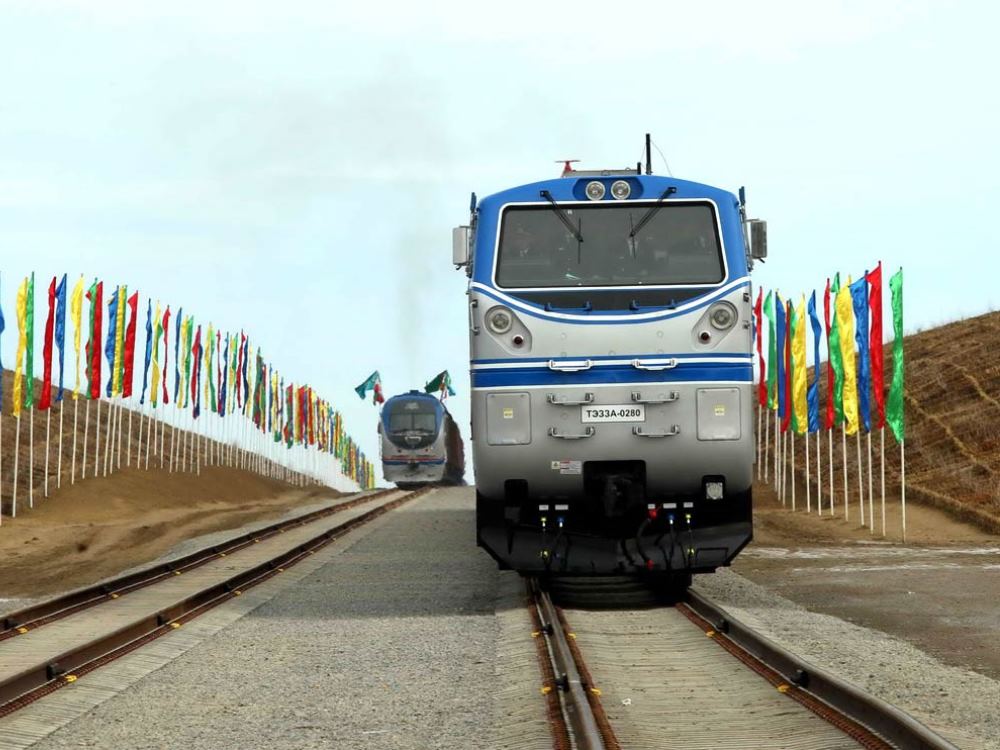Rail Revolution to Boost Trade, Investment

EghtesadOnline: Ancient Persians would have cheered the commissioning by Iranian President Hassan Rouhani and Azerbaijani President Ilham Aliyev in March of a new railroad connecting their countries.
The Persian ancestors were able to rule over much of West Asia in part because they understood the strategic importance of transportation and organized one of the world’s first highways: the Royal Road.
The route spanned all of modern-day Iraq and Turkey, and cut messengers’ travel times by a factor of 12, reads an article published by Japanese business publication The Nikkei. according to Financial Tribune, excerpts follow:
Under President Rouhani, who faces reelection on May 19, Iran has made its own bid to replicate the feat of his ancient predecessors. An increasingly impressive network of road and rail links is tying Iran into the global trading patterns of powerful neighbors. Although Iran’s ambitions are large and strategic, small railroad projects like this one play an important role.
The new section is only 10 km long, linking Astara in Iran to Astara in Azerbaijan. It is one of the final pieces to complete the International North-South Transportation Corridor, which will connect India and Russia via Iran.
When the corridor is completed later this year, its government and private sector supporters expect travel on this route will be twice as fast as via the sea, which requires passage through the Suez Canal and the Strait of Gibraltar, before the English Channel and ending somewhere on the northern coast of Europe.
While shipping remains the lowest cost option for long distance trading, the speed of rail matters for many goods. Fresh foods such as apples, onions, citrus fruit and melons can survive a 20-day train trip from Mumbai to Moscow, for example, but would rot if they spent 40 days in a container at sea.
With the continuation of European sanctions on Russia, the idea of a reliable supply route to the country that circumvents Europe is attractive to Russian and Indian shippers.
Iran also stands to benefit from increased transit cargo. At present, roughly 1.5 million tons of foreign cargo are carried by its railroads annually. With the INSTC fully operational, Azerbaijani railroad officials predict that figure will more than triple to an average of 135 fully laden rail cars every day. Over the longer term, some think that figure could double yet again.
Combined with an already robust truck trade, India-Russia business transiting through Iran would generate both needed tax revenues and jobs for the Iranian economy.
Beyond its economic logic, this new railroad helps return Iran to what it sees as its historic role. As its former transportation minister, Ali Nikzad, said recently, “Iran lies on the crossroads of the East and the West and the Silk Road. This is not a random event. It is history which says Iran is the point of equilibrium in the region.”
In From the Cold
Reclaiming that status will not be easy, though. Decades of international sanctions dried up funding for new projects, diverted commerce and scared away many global investors. Railroads suffered.
Until recently, Iran struggled to add more than 200 km of railroad each year.
Now, the mood in the Iranian railroad industry has changed. With the lifting of international sanctions and western investors now exploring Iran, the country now plans to add nearly 2,000 km of railroad every year for the next five years.
New links to Russia, India and Central Asia fuel visions of further progress.
India, Italy and Russia have already stepped up to invest. European companies have signed agreements to supply locomotives. Altogether, the Iranian government reportedly has identified $10 billion worth of rail projects ripe for foreign investment, committed half a billion dollars of its own funds, and pledged 1% of oil revenue, which is expected to hit $41 billion in 2017, to its rail sector for the next five years.
No country has been more eager to help Iran than China. President Xi Jinping was the first head of state to visit Tehran after US sanctions were lifted last year. He signed an agreement to develop Iran’s first high-speed railroad and pledged to increase bilateral trade with Iran to $600 billion annually by the end of a decade. A few weeks later, the first freight train to connect China and Iran arrived in Tehran.
Like Iran, China is seeking to repeat—and in some respects, rewrite—history. Invoking the ancient Silk Road, its massive Belt and Road Initiative aims to connect an expanding list of countries, constituting some 70% of the world’s population.
New Rail Projects
A number of other rail projects are also underway. Russia is financing the modernization of a railroad between Iran and Turkmenistan. New lines are being built to connect Iran with Basra in Iraq and with Herat in Afghanistan. Those projects that succeed will encourage new patterns of commerce, and over a longer period, could drive relations between the participants.
Iran has a bigger population than France and more than twice as much territory, but less than half the total railroad track. Trucking is a major industry in Iran, but compared to rail, it is expensive, inefficient and polluting. Expanding Iran’s rail system makes good economic sense.
The wider region could benefit as well. Iran can be a market for its neighbors and its robust industrial base means the country can also be an impressive producer. Economic integration is good for regional stability.
Success in all of this is by no means guaranteed. Deeper connections often have unpredictable outcomes.
Darius’s road was a central tool in maintaining his empire and the same road helped Alexander the Great conquer it. Better infrastructure will not make Iran’s economic success inevitable, but it certainly will shape the strategic landscape in which Iran makes its future decisions.


